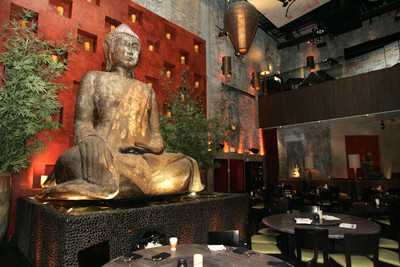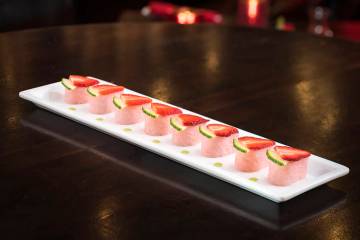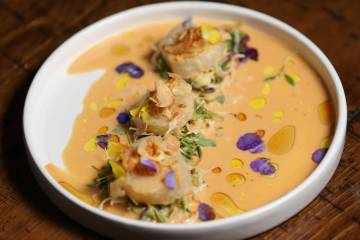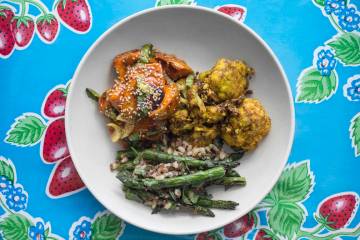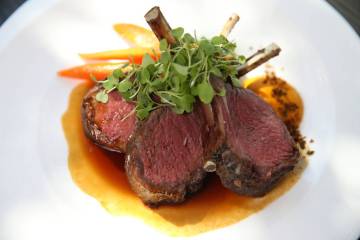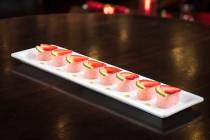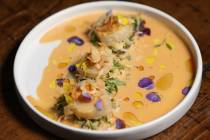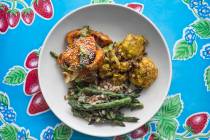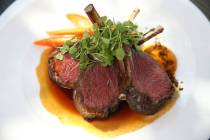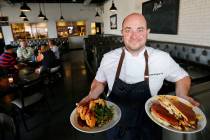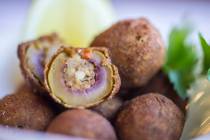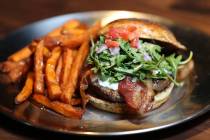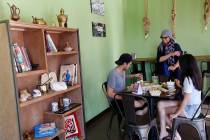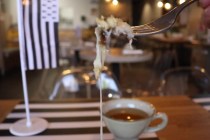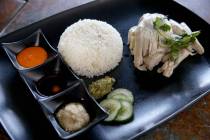Tao Asian Bistro
One of my earliest memories connecting food to the garden regards chive flowers. When I was a little girl, both my mother and my grandmother would send me out to their respective herb gardens to pluck the flowers from the chives so they wouldn't "go to seed," according to the conventional wisdom of the time. As I'd discard those beautiful fluffy lavender-colored flowers, I always wondered if they were edible.
Well they are, of course, and are quite useful in vinegars and salads and so forth. And so I was pretty excited when I saw on Tao's menu Braised Spicy Shrimp with Chive Flowers ($28). (Braised shrimp? That's what I thought. More on that later.) Except that there were no chive flowers. And so I thought, well, maybe they really meant the flowers of Chinese chives, which are not fluffy or lavender but white and sort of streamlined. Except that there weren't any of those, either. Just a lot of braised chives in a very attractive nestlike arrangement around the shrimp and the rice on which they rested. Which would be OK except that braised chives taste a lot like grass.
Well, darn. But that was the way with many things during our dinner at Tao: They sounded good, but didn't quite measure up.
The Tao-hito cocktail, for example, which our waiter said was "our take on a mojito," and which was nice and refreshing and adorned with a section of sugar cane, but which was pretty much yeah, your basic mojito, "our take" or not.
There was the sweet onion tempura ($4), characterized by a very heavy flavor of stale oil, which meant that it either was not fresh enough or not hot enough or both. Actually, I was glad we ordered the onions, because I might have overlooked the oil problem in the more strongly flavored Kobe tartar (or tartare, to you and me) tempura ($19), and the crispy tuna sashimi roll ($15).
Both of them were really pretty good and I'd order them again, stale oil and an aversion to fried foods notwithstanding. The first was a nicely seasoned steak tartare (probably using Wagyu, also called "American Kobe," although why you'd chop up and season a premium grade of beef that's known for its tenderness and flavor is beyond me), coated in tempura batter, fried, sliced and served with a sort of sweet-and-sour sauce.
But I think I preferred the tuna, a dish that was by definition an oxymoron. Tuna sashimi is just raw tuna unadorned, and here it was tricked up with a tempura coating, but at least the tuna remained raw and was of a nice, sashimi-grade quality. And the horseradishy sauce on the side that was no doubt meant to evoke wasabi but also tasted a bit of mustard was a perfect complement to the more austere flavor of the fish.
"Succulent" is one of those restaurant-reviewer words but the only one I can use to describe the Roasted Thai Buddha Chicken ($26), which was moist and meaty and, as our waiter had advised, not overly spicy, with hints of traditional flavors like star anise and ginger and cinnamon.
And we loved the chocolate-raspberry won tons for dessert ($9), which were a perfect balance of both distinctive (and very complementary) flavors in crispy-fried jackets and with a scoop of a distinctively flavored vanilla ice cream.
And yes, that's a lot of fried. I wouldn't say the menu leans overwhelmingly in that direction, but it does seem to be the cooking style of the most interesting dishes and of course the respectable list of tempura and some of the sushi to boot. I think that's probably because in general, and especially later in the evening than we were there, the trendy Tao has a trendy young clientele.
Which also explains the truly exotic decor, which alone is reason to go to Tao because it's pretty cool, no doubt about it. I'd take visitors there just for that.
And which also explains the fact that Tao is, allegedly, the highest-grossing restaurant in the country. Actually, there's something else that explains that; this is a place that clearly wants to turn its tables. Service from our waiter and his assistant was quite good, but even the appetizers came out too quickly, and though we dug right in, we hadn't quite finished when the entrees arrived. And the runner who brought the entrees just stood there with them in his hands and sort of roughly gestured for us to move the appetizer plates aside so he could put them down, which he did unceremoniously and then departed. Hmmm. A waitress we'd had in a poker bar a few weeks back showed more concern when the entrees came too quickly.
And which brings us to another point, and back to the shrimp. As you no doubt know, in braising, food generally is cooked in liquid at a low temperature for a long time. And shrimp generally is cooked at a high temperature for a very short time. And well, whatever method was used to cook these shrimp, they were overcooked to the point that I didn't eat more than three. Nice-sized shrimp, too. A shame to turn them to rubber.
So, back to the table-turning issue. Here's some advice for Tao: Want to turn those tables even faster? Don't cook the shrimp so long.
Las Vegas Review-Journal reviews are done anonymously at Review-Journal expense. Contact Heidi Knapp Rinella at 383-0474 or e-mail her at hrinella@ reviewjournal.com.
HEIDI KNAPP RINELLAMORE COLUMNS
Audio review what: Tao Asian Bistro where: The Venetian, 3377 Las Vegas Blvd. South phone: 388-8338 overall: B+ food: B atmosphere: A service: B pluses: An atmosphere as exotic as it gets. minuses: Things that didn't quite measure up.



